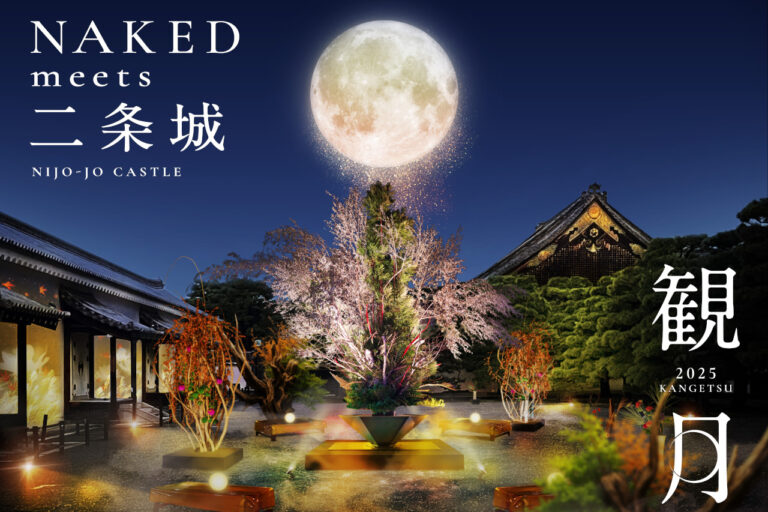
NAKED meets 二条城 2025 観月/元...
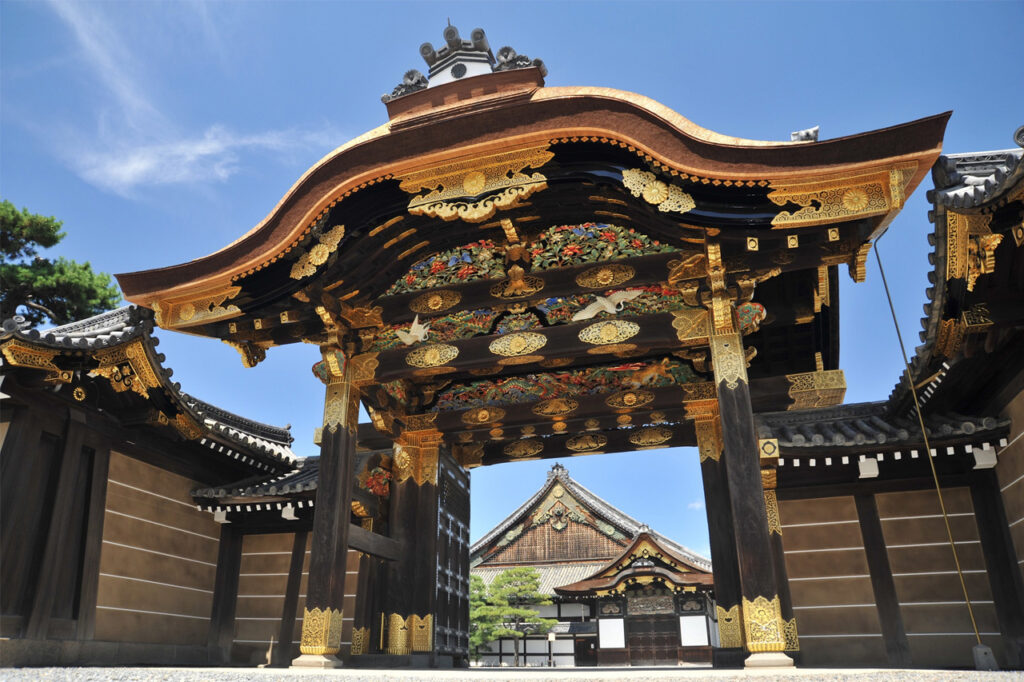

国内外から多くの人が訪れる京都の人気観光スポット[二条城]。城内に入ると街中から一変、豪壮な歴史建造物と緑豊かな庭園が広がり、春はヤマザクラやサトザクラ、ヤエベニシダレザクラなど約50品種300本の多種多様な桜を楽しめる。紅葉の名所としても知られ、これからの季節はイチョウやカエデなどの多彩な木々が美しく色づく景色も見ものだ。
In this issue, we will introduce not only the basic information you should check out when visiting Nijo Castle, but also some unusual sights such as the mysteries hidden in its history.
Photo courtesy of Nijo Castle Office, Motorikyu Nijo Castle, Kyoto City
Construction began in May 1601 by order of Tokugawa Ieyasu, the first shogun of the Tokugawa Shogunate. In March 1603, Ieyasu entered Nijo Castle for the first time and went to the imperial palace to pay his respects to the shogun. He invited the feudal lords, the prince, court nobles, and other dignitaries, and held a splendid banquet in the castle, strongly impressing them with his authority as Shogun.
In 1605, the castle was again the site of a banquet held in honor of the Shogun's reception of the second Shogun, Hidetada; in 1614, it was the site of Ieyasu's departure for battle during the Osaka Winter and Summer Campaigns; in 1620, it was the starting point for Kazuko, the fifth daughter of Hidetada and Oe, when she entered the city as a princess to link public and military life. Then, in 1626 (Kan'ei 3), the greatest event since the castle's construction took place. A gorgeous procession was held from the Imperial Palace to [Nijo Castle]. Hidetada ordered repairs to set the stage for the procession, and the castle underwent a major renovation during the Kan'ei period.
The Shogun had not entered the castle for a long time after the period of peace under the Emperor, but the era moved into the turmoil at the end of the Tokugawa Shogunate. After about 230 years, the 14th shogun, Iemochi, visited the castle. In October 1867, the 15th Shogun, Yoshinobu Yoshinobu, announced his intention to return to the shogunate at Ninomaru Palace, and in 1868, the Meiji Emperor went to Nijo Castle and issued an imperial rescript declaring the establishment of a new regime. It is well known that this was the historical stage that brought an end to the long-lasting samurai society and triggered Japan's move toward modernization.
明治政府が発足すると[二条城]は京都府庁として使われることに。その後皇室の離宮となり[二条離宮]と名を改め、国内外の賓客を迎える場ともなった。1915(大正4)年には大正天皇即位の大礼が行われ、皇族や国内要職者、外国人使節ら錚々たる顔ぶれが即位を祝う煌びやかな大饗宴の舞台となる。
In 1939, as the Showa period came to an end, it was given to Kyoto City by the Imperial Household Ministry and opened to the public.

Karamon, the main gate of Ninomaru Goten. It is a four-legged gate with a 10-meter-high gabled roof with a cypress bark roof. [It is the most prestigious of the many gates of Nijo Castle.

The main gate of Ninomaru Goten, built in 1625 (the year before the Kan'ei Gyoko-do). The entire space above the pillars is filled with carvings of dragons and tigers, as well as cranes, turtles, butterflies, pine, bamboo, and plum, all symbols of longevity and prosperity. The dragons and tigers carved facing each other on the central beam are symbols of protection for the castle, and ten Chinese lions can be found throughout the gate. It is fun to look for them while taking into account the significance of each sculpture.
The chrysanthemum crest attached to the karahafu (gable) has a little secret behind it. The chrysanthemum crest is a symbol of the imperial family, but traces of the Tokugawa family's hollyhock crest remained on the reverse side of the chrysanthemum crest found during the Showa repair. Furthermore, during the Heisei era's major repairs, it was discovered that the small metal fittings of the rafters that support the roof have a hollyhock crest below the chrysanthemum crest.
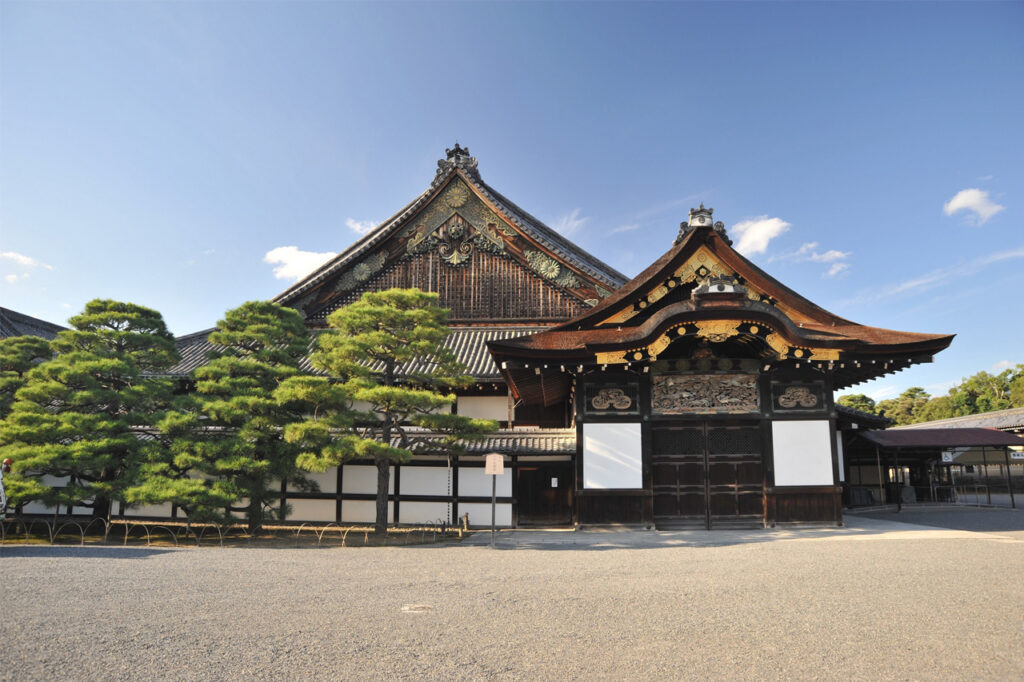
Ninomaru Palace

It was built as the residence of the Shogun during his stay in Kyoto, and underwent a major renovation during the Kan'ei Gyoko period to its present form. The six buildings, each with an irimoya (gabled) roof and arranged in a row in the shape of a wild goose, have 33 rooms in the samurai-style shoin-zukuri style, with approximately 800 tatami mats and a total corridor length of 450 m. The building was also used as the shogun's residence during his stay in Kyoto. An additional highlight is the more than 3,600 paintings on the walls by the Kano school, a leading group of early modern Japanese painters who, as the shogunate's official painters, were solely responsible for creating the paintings that adorned the halls during the Kan'ei Gyoko no Taiyo renovation. The Ninomaru Palace features both the old and new styles of painting: the grandiose Momoyama style, which was inherited from the Momoyama School, and the new style that eliminates depth.
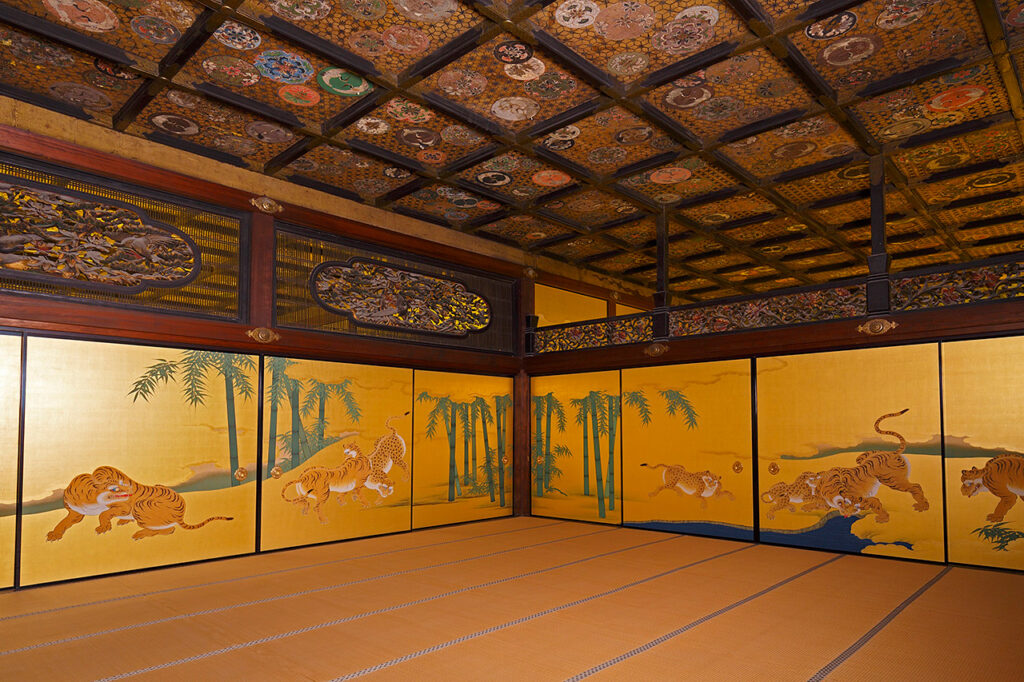
The painting of the Ensamurai, in which the tiger's eyes are painted at the same level as the seated visitor's gaze, is designed to add to the sense of intimidation.

The largest wing of the Ninomaru Goten, the Tohsamurai is the first place visitors enter. The rooms from 1-no-Ma to 3-no-Ma, which were used as an antechamber, are painted with a fierce tiger, glaring menacingly at the visitor. Visitors must have been nervous as they waited to be shown the way.
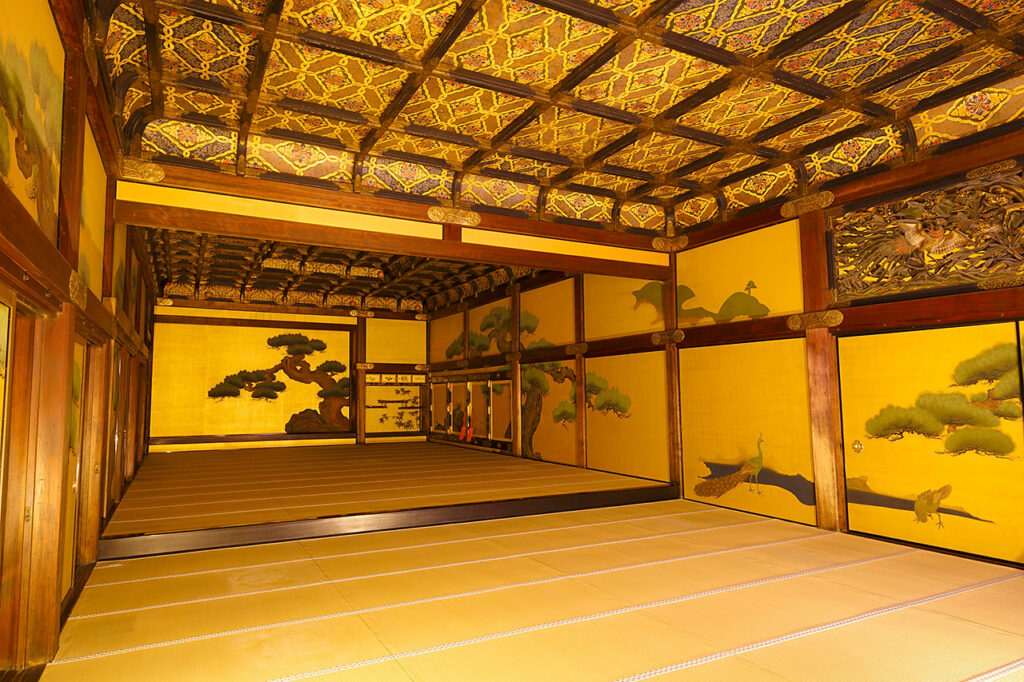
The pine trees in the hall, painted using the visual effect of space, are a stage set-up to further enhance the Shogun's authority.

This is the most official hall in the Ninomaru Palace, where the Shogun officially meets the lords and other dignitaries. The boldly painted pine tree is a device to emphasize the Shogun's dignity. The pine tree on the wall behind the Shogun in the front of the Ichinoma Room arcs above his head as if it were protecting him. The pine trees on either side of the Shogun's head are drawn so large that those looking up from the lower level feel as if the Shogun is farther away than he actually is. The ceiling of the Ichi-no-ma room, where the Shogun sits, has a double-high folded ceiling, indicating his high status.
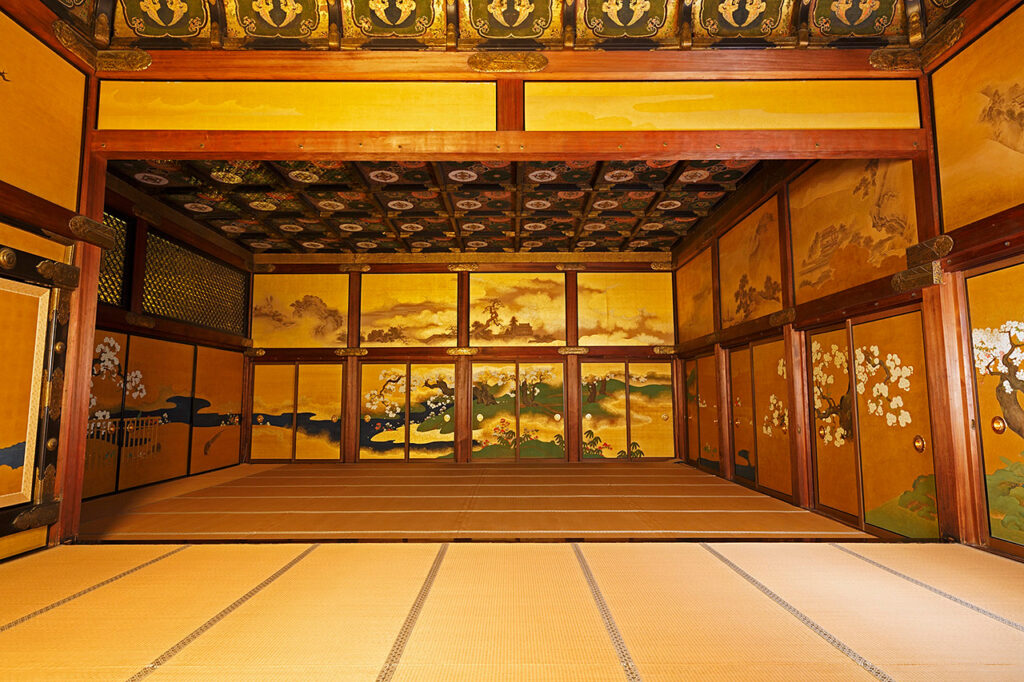
The Cherry Blossom Room (Room 1, Room 2) in the Black Drawing Room depicts a peaceful spring with wild birds and parakeets playing by the water as the cherry blossoms move in and out of the room.

From the grand hall, the impression changes completely to the Kuroshoin. Here, feudal lords and high-ranking court nobles close to the Tokugawa family met. The paintings on the wall depict flowers and trees of the four seasons. Pine trees are also painted in different ways to give a neat impression. The ceiling in the Ichi-no-ma room only has an orijo-gakuteme ceiling, with arabesque patterns on a gold background and phoenixes painted in rich colors, indicating the special status of the ceiling.
Designated as a Special Place of Scenic Beauty by the government in 1953, this is a garden with a pond and garden fountain. The floating islands of Nakajima, Tsuru-jima, and Turtle-jima in the pond were designed based on the Chinese idea of the sacred hermit Horai, and the many rocks along the edge of the pond create a richly varied landscape.
It is believed to have existed from the time the castle was built, and Kobori Enshu and others directed the major renovation during the Kan'ei Era (1615-1644) to create the present prototype. The garden had previously been a garden that could be viewed from the hall and Kuroshoin, but when the Gyoko-den palace was built for the emperor, the garden was created with the view from the palace and other places in mind. From the Great Hall and Kuroshoin, one gets the impression of a samurai house with many steep rocks, while from Gyoko Goten, one can see a softer scene centered around the mirror stones placed in the center and on the left and right sides.
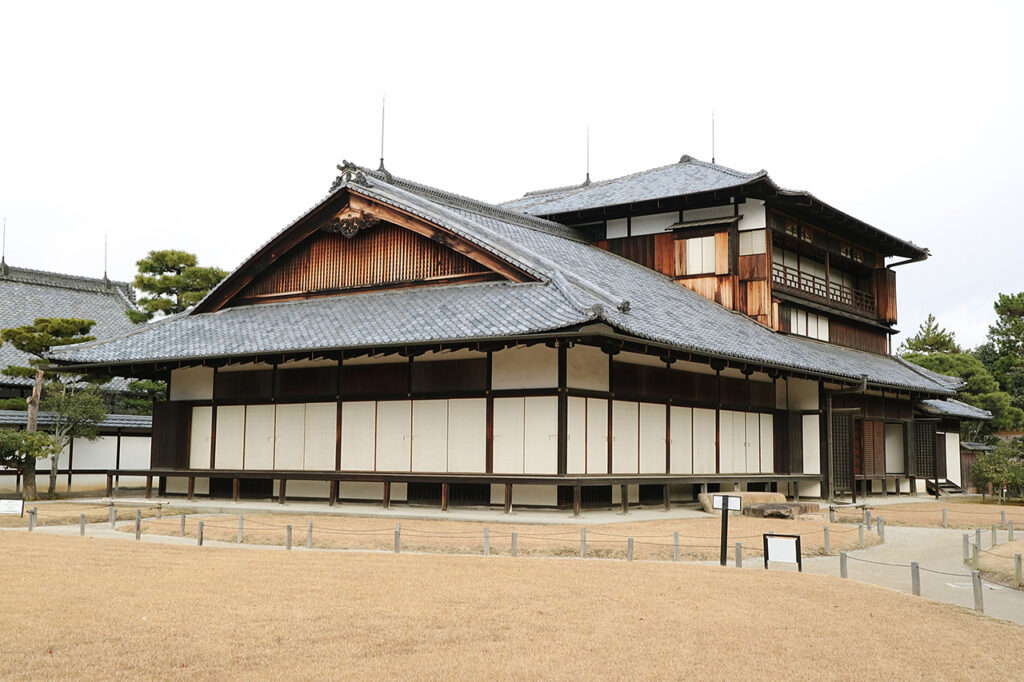
Goshogoden, a residential building of the imperial family in the Edo period. The mukuri roof with a bulge in the center is often seen in sukiya-style architecture. The rounded roof gives the building a gentle atmosphere that is typical of buildings belonging to the imperial family. Open to the public from September 1, 2024 (see website for details).

The Honmaru Goten, with its distinctive rounded roof, is an elegant building, which was moved from the Katsuragamiya Palace, which was called Katsura Palace, from 1893 to the following year after the Honmaru Palace was destroyed by fire in 1788. The main building, which was used as a sitting room during the Katsuragamiya period, has an attached shoin-style drawing room in the first room, which has a ventilation hole that can be raised and lowered under the wooden floorboards. The second floor is designed in the sukiya style and overlooks the garden. The second floor is designed in the sukiya style and overlooks the garden. The kitchen, which still retains the electrical equipment used for the Taisho Tairei banquet, and the aristocratic entrance hall are also highlights of the building.
Also noteworthy here are the paintings on the walls. Works by painters active from the end of the Edo period to the Meiji period adorn each room, and the elegance unique to the Miyake family, such as seasonal flora and fauna and rural landscapes, is accentuated in their style. (Some of the paintings are not open to the public.)
Nijo Castle and its surroundings, which have been repeatedly burned down and renovated, have changed with the times, and in addition to the architecture, there are historical techniques that should be observed closely and mysterious sights that deepen the mystery.
<Difference of stone wall
First, I would like to introduce the stonewalls, which are the cornerstone of the defenses and a sign of the lord's authority. The first of the three main techniques used is field masonry, which remains in the area from the northwest corner of the outer moat to the east. The second technique is "Uchikome-tsugi," which can be seen especially in the inner moat. This technique is used to pile roughly processed stones to reduce the gaps between them, thereby increasing the strength of the wall and making it possible to build a stone wall higher and steeper than field masonry. [The third is kirikomi-tsugi, a more sophisticated version of the huchikomi-tsugi technique. The third is kirikomi-tsugi, which is a more refined version of the Uchikomi-tsugi technique. This technique aims to pile up stone walls without gaps, but although it has a more pleasing appearance, it is inferior to Uchikomi-tsugi in terms of strength. You can see the difference in some of the stonewalls inside the west gate.
In addition, the stone wall that runs east of Horikawa-dori still bears engravings indicating the names of the feudal lords who were entrusted with the construction of the castle at the time of its construction. Unique markings such as "Maru ni Yama" (mountain in a circle) and "Niju Maru" (double circle) are engraved on the stonewalls, so please look for them as you stroll around the area.
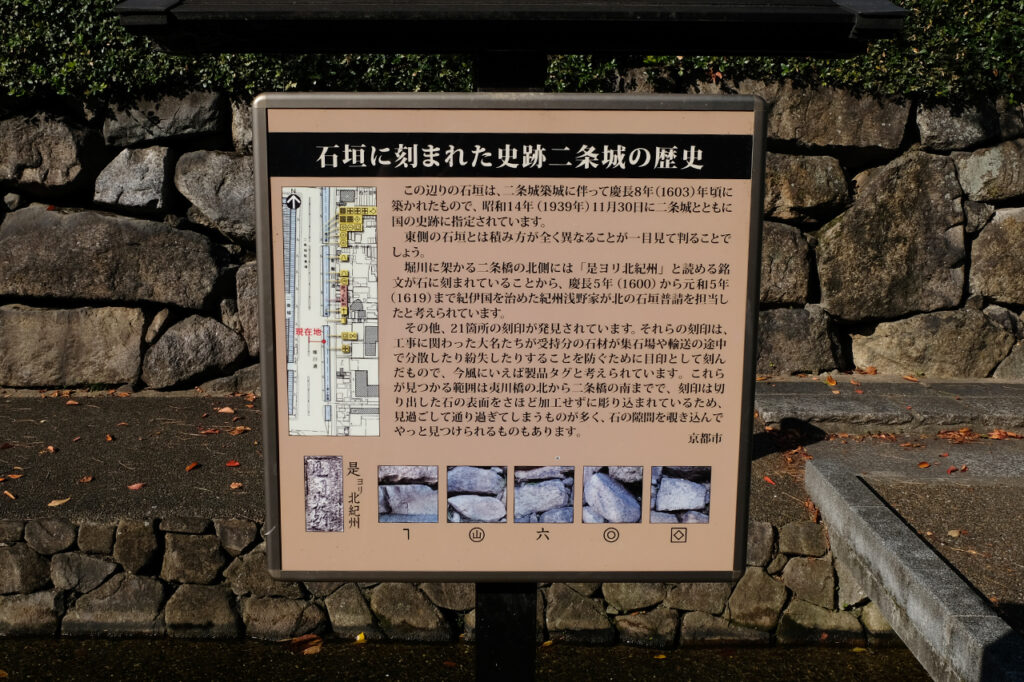

<Nijo Castle, tilted at a three-degree angle.
Kyoto City has streets running east-west, north-south, and south-south in a grid-like pattern. However, it is not well known that Nijo Castle is not parallel to Horikawa-dori, but is actually tilted at an angle. The reason for this is unclear, but the north-south axis is tilted 3 degrees to the east. Walking along Horikawa-dori, where the East Main Gate is located, you will not notice that the square in front of the gate becomes narrower as you move north, unless you are conscious of it.
<Three detached palaces in a straight line
Katsura Rikyu, Shugakuin Rikyu, and the former Nijo Rikyu (Nijo Castle) are the three remaining detached palaces in Kyoto. In fact, these three palaces are located on a straight line when viewed on a map. Even the Imperial Palace is on this line. Katsura Rikyu was built by Emperor Gosui's uncle, Prince Tomohito Hachijo, and Shugakuin Rikyu was built by Emperor Gosui himself, all of which are related to Emperor Gosui who went to Nijo Castle.
他にも、御所や門跡寺院に見られる5本線の筋塀が[二条城]でも使われていたりと不思議な謎はあちこちに。何度訪れても新たな発見に出合える奥深さも魅力だ。
From Exit 1 of Nijojo-mae Subway Station
Short walk
From JR Nijo Station
17 min. walk
By bus from Kyoto Station
B1 boarding area
Route 9 (for Nijo Castle and Nishigamo garage) → get off at Nijojo-mae bus stop → a short walk
B2 boarding area
Take the No. 50 bus (bound for Ritsumeikan University)→get off at the Nijojo-mae bus stop→a short walk
By bus from Karasuma-Shijo Subway Station
Bus stop D (south side of Shijo St.)
Board the No. 12 train (bound for Kinkakuji or Ritsumeikan University) →exit at the Nijojo-mae bus stop →short walk
●駐車場(乗用車) ※シーズン料金有(3/10~4/10、11/1~11/30)
Parking Lot 1 (east side of Nijo Castle)
台数/120台 ※3月~6月、9月~11月は54台
Hours of operation/8:15-16:00 *Opening hours change according to the opening hours of the castle during events, etc.
Fee/40 min. 600 yen, max. 1800 yen for the day
Parking Lot No. 3 (south side of Nijo Castle)
Number of units / 20 units
Opening hours/8:15-16:00 *Opening hours change according to the opening hours of the castle during events, etc.
Fee: 1000 yen for up to 2 hours, 200 yen per hour thereafter
Bicycle parking lot
Number of vehicles: 10 motorcycles (no large bikes), 83 bicycles
Opening hours/8:15-16:00 *Opening hours change according to the opening hours of the castle during events, etc.
Fee/Motorcycle: 400 yen for up to 2 hours, 200 yen per hour thereafter
Bicycle: 200 yen for up to 2 hours, 100 yen per hour thereafter
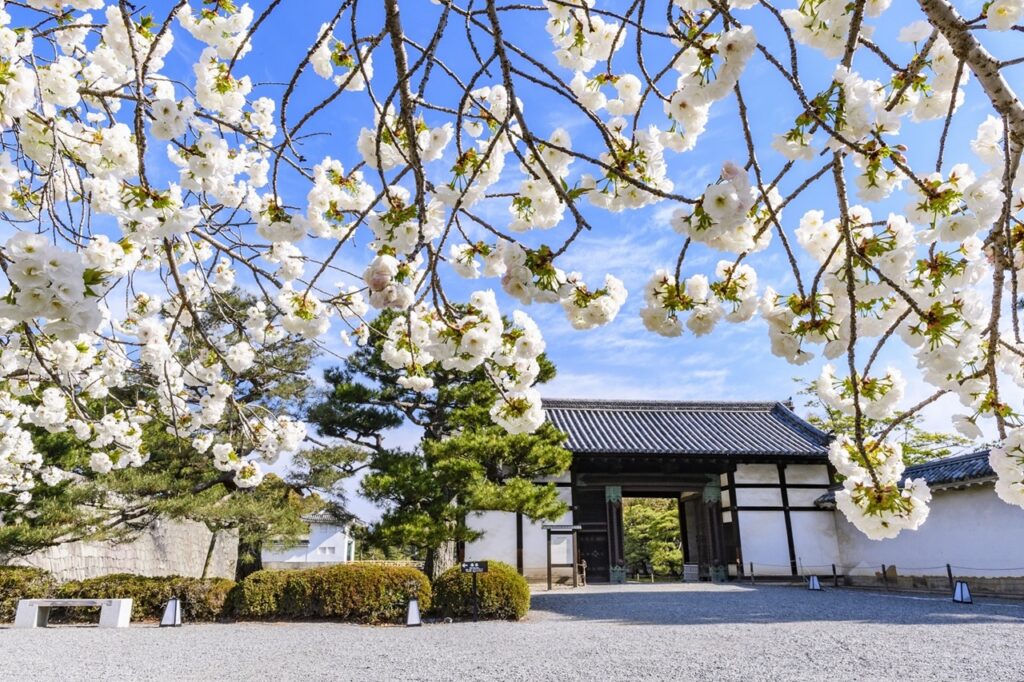

Cherry blossom viewing information
見頃/例年3月下旬~4月中旬
Entrance time/8:45-16:00 (Castle closing/17:00)
※二の丸御殿の観覧受付時間は8:45~16:10
Autumn leaves season information
Best time to see/usually mid-November to early December
二の丸御殿障壁画 展示収蔵館 秋期原画公開「黒書院の秋~<黒書院>四の間」
期間/2025年10月9日(木)〜2025年12月7日(日)
時間/9:00〜16:30(最終入館/16:45)
入館料/100円(未就学児無料)※別途、入城料が必要
Over 600 interviews per year! An order site carefully selected by the editors who knows Kyoto and Shiga.
nowOfficial LINE friend registration500 yen OFF coupon is being issued!
Distributed every Friday morning at 8:00 am! From new restaurant information to event information that we want to share with you, We deliver articles about Kyoto that are useful to know. About 20,000 people have registered.Click here to add a friend!
 News
News Feature article
Feature article Featured event
Featured event